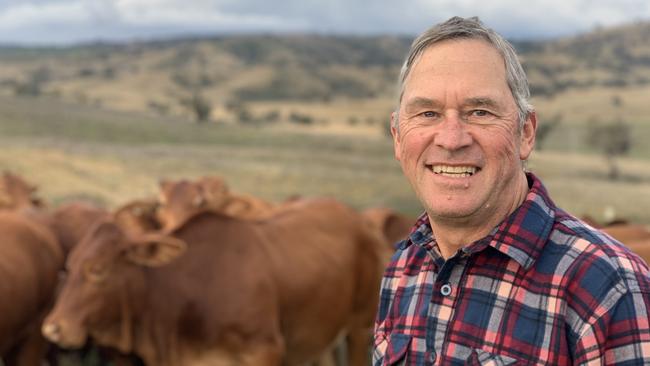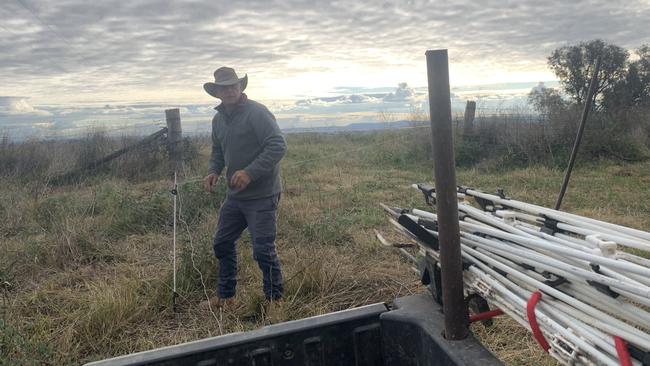Holistic approach takes farming to whole new level
Getting down and dirty comes naturally to this champion of holistic farm management.

Measuring cattle dung scores and urine pH is not the most glamorous farming job.
But for Ian Chapman it is essential.
“Grass is higher in energy at the top and higher protein at the base,” said Ian, who runs a 400ha cattle property near Orange in NSW with his wife Sharon.
“It’s complex and not prescriptive, but if animals eat down low to the base then they are more prone to have excess protein in their diet.
“If they eat the top third their diet is more likely to get a good balance and not produce excess ammonia and the bugs in the rumen will be happier.”
Hence, he said, by visually monitoring dung, Ian can ensure on a scale of 1-5 – (with 1 being wet and 5 dry) – cattle dung is a 3, also litmus testing grass sprayed by cows with fresh urine.
This is just one of the tools that Ian has adopted to ensure his property – which currently has destocked to about 80 Droughtmaster breeders – maintains Land to Market verification.
Land to Market is a global program operated by the Savory Institute, focused on regenerative farming through holistic management, providing members with training, mentoring and verified branding of their produce.
In Australia Land to Market is run by the Australian Holistic Management Cooperative Limited, where Ian is a board member.
SEAL OF APPROVAL
Ian said their Ecological Outcome Verification was an assessment scheme to measure the health of soil, biodiversity and ecosystems, and was not focused on practices but outcomes, verification not certification.
“Certification – such as with organic practices – is all about what you can and can’t do,” he said, adding there were almost 40 Land to Market farmers across Australia.
“We don’t adhere to that. We monitor the land and verify what we see and once it’s verified a farmer gets a marketing seal to use on their value-added products, which tells the consumer they can trust these products have come from “farm land that is improving in ecological health”.
“Supporting the verification process is a commitment by our members and partners to the values of our co-op. We don’t want greenwashing, we want valid outcomes.”
The Chapman farm is a good example of the verification process.
Ian first worked on the 400ha property as a manager – fresh out of agricultural college – in 1981, eventually buying the property in 1988.
In those years it was run conventionally, initially as a sheep property, then including cattle, and for about six years Ian and Sharon ran a value-add pork business, until a large storm in 2018 put a stop to the enterprise.
ALWAYS LEARNING
Ian said he first studied Yeomans Keyline Systems, which “made me think we could be doing better”.
“The saying at the time was you can’t be green when you are in the red, but I always felt we could be improving the land not at the expense of profit.
“If you are fighting nature it’s expensive.”
He then studied holistic management – including time in the USA after winning a NSW Teacher’s agricultural scholarship – and then became a certified educator of the course.
In 2016, Ian founded Hooves 4 Humus, part of a global Savory Institute network of hubs, offering training, consulting and research.
The hub still exists today but has largely transformed into the Australian Holistic Management Cooperative, where Ian verifies other members’ farms.
The process involves monitoring short term and long term goals.

One key focus is ground cover: “I hate bare ground.”
The gravel/clay shale soil has a mix of conventional, historically-sown pastures of phalaris, cocksfoot and subclover, as well as natives such as weeping grass and warrego summer grass.
The property receives an average annual rainfall of about 700mm and the past 12 months had been “brilliant”, with 890mm in 2020, a welcome relief after three years of drought, which forced the Chapmans to destock.
“We monitor warm season grasses, the perennials, seeing which ones are present, and whether they have crown integrity: if they aren’t managed well you start to see them dying in the middle.
“It’s quite technical work and relative to the ecoregion.”
MONITOR ROLE
Ian monitors insect activity through to soil health and plant biodiversity.
He adopts a planned grazing approach, with cattle generally moved daily.
“A lot of people talk about intense grazing or rotation or cell grazing. But planned grazing takes into account everything in our management, from plant recovery to the people side.
“If I need to change the rotation to suit my own needs I do.
“I’ll adjust livestock numbers according to the season and I adjust early.”
Cattle are largely sold through the Central Tablelands Livestock Exchange at no fixed time or weight, with Ian generally chasing hybrid vigour through Droughtmasters, Charbray and Santa Gertrudis blood lines, joining on New Year’s Day to Angus bulls.
Ian said regenerative farming was difficult to certify because it was ever-adapting, with continuous learning, and farmers encouraged to try techniques specific to their region, with often unpredictable results.
“Nature is complex and practices fall into broad categories. It can be ambiguous and can’t be put in an easy box.
“It’s not for us to say which is the best practice and that’s why I’d much prefer to focus on ecological outcomes than practices.
“If you put on a lot of synthetic fertiliser, look at the results. Will that give you diversity in warm and cool season grasses, or increased ground cover? If through assessment we can show these are improving then why not use inputs?”
MORE
VICTORIA’S BIGGEST MERINO STUD BRINGS DATA KNOW-HOW LEARNT IN CROPPING TO GROW BUSINESS
LIVE EXPORT INDUSTRY STILL STANDING, 10 YEARS ON FROM SNAP BAN


